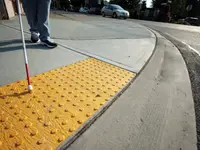In Part 2 of our series for small towns, parishes and municipalities in Louisiana that want to build ADA compliant streets, we tackle the financial aspect of ADA street compliance. Streets and highways can pose a substantial challenge with both initial modification costs and continuous maintenance expenses. The cornerstone of effective budgeting, however, is understanding urgency, relevance and prospective timeline.
One-Time Costs: Installing curb ramps, enhancing pedestrian signals, or modifying sidewalks for increased accessibility may be a bit overwhelming at first glance. These changes, while crucial for initial compliance, are usually one-time costs. Formulating a budget for the one-time and then ongoing spend will help manage overall costs. Prioritize areas that pose the most significant accessibility barriers or regions frequently used by citizens with disabilities. Begin modifications in these areas to make the most immediate impact.
Ongoing Costs: Remember that ADA street compliance along streets and highways are an ongoing commitment; therefore, budgets should also take into consideration future expenses. This includes costs related to maintenance, repairs, and potential upgrades to keep the town’s infrastructure in line with evolving ADA standards. Many small towns, parishes and municipalities in Louisiana cannot enact all the necessary changes at once due to financial constraints; and that is okay. Focus on making steady progress towards ADA compliance, one project at a time.
Funding Sources: There are a plethora of funding sources and creative means by which to implement an ADA compliance strategy in your small town or municipalities. Choosing to work with an expert who knows the financial landscape will ensure you’ve maximized all potential funding avenues. Below are some of the options that an expert might explore:
- Local Taxes or Public-Private Partnerships (PPPs) are some of the most common and most used ways to support ADA compliance
- Federal and State Grants specifically allocated for such improvements included programs like the Community Development Block Grants (CDBG) designed to help communities with various development needs, including ADA compliance
- Budget Earmarking is a strategic approach that identifies a specific portion of the town’s annual budget for ADA compliance; effectively integrating it into regular infrastructure investment
- Fundraising is a means to engage the community in the process of achieving ADA compliance while fostering a sense of ownership and commitment amongst town residents (examples: local events, crowdfunding, or donations from local businesses)
- Low-cost loans may be access from The Department of Transportation’s Infrastructure Finance and Innovation Act (TIFIA) program and provides loans with flexible terms for various infrastructure projects, including those related to ADA compliance
ROI: Striving for ADA compliance means a small town is signaling their respect and consideration for all citizens, which in turn strengthens the fabric of the community. When every resident matters it helps enhance the town’s reputation, making it a more attractive place to live, work and visit. This type of infrastructure is an investment in the town’s future, laying the groundwork for a thriving, inclusive community.
Risks: Importantly, achieving ADA street compliance protects small towns from potentially expensive legal action. Non-compliance may lead to costly lawsuits, straining the resources of small towns, parishes and municipalities in Louisiana. Proactive compliance efforts, therefore, serve as a safeguard against such risks.

